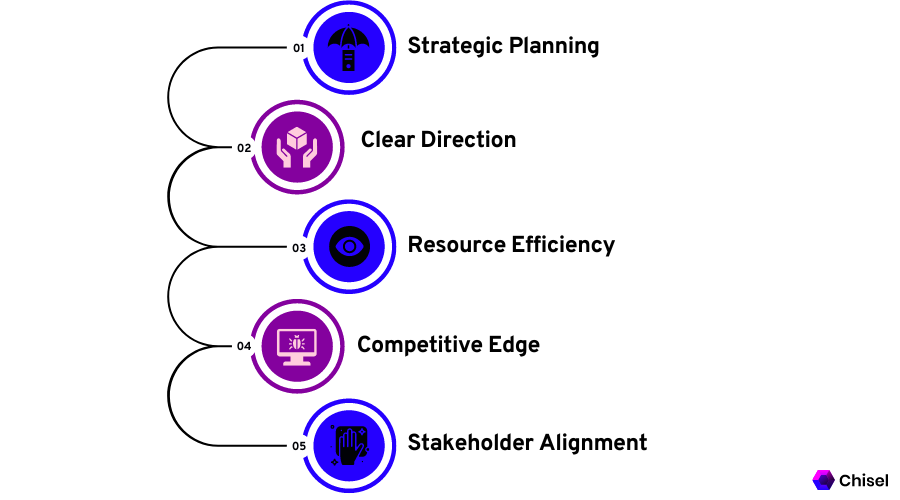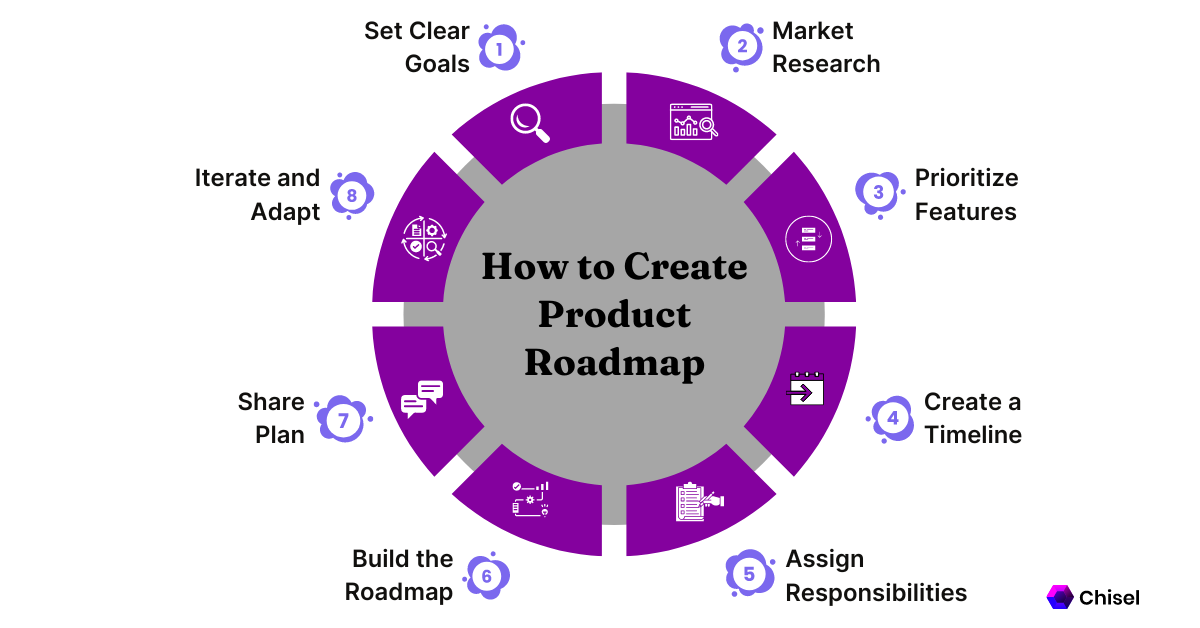What Is Product Roadmap? The 2024 Complete Guide

This article covers:
- What Is a Product Roadmap?
- Which Teams Need Product Roadmaps?
- Why You Need a Product Roadmap, Even if You’re a Small Business?
- Essential Elements of a Successful Product Roadmap
- How to Create a Product Roadmap That Deliver Results?
- Presenting Product Roadmaps to Stakeholders
- Start Crafting Product Roadmap for Your Business
Do you want your business to succeed? Then you need a product roadmap.
A product roadmap is a plan for how your product will evolve. It outlines your product’s vision, goals, and priorities. It also helps you communicate your product’s strategy to your team, stakeholders, and customers.
Without a product roadmap, your business is flying blind. You’ll be making decisions without knowing where you’re going. You’ll be wasting time and resources on features that don’t matter. And you’ll be leaving money on the table.
On the other hand, a meticulously crafted product roadmap fosters clarity, alignment, and seamless collaboration among teams. It establishes a clear vision, allocates resources wisely, and empowers organizations to adapt swiftly to market dynamics.
So what are you waiting for? Get that roadmap and watch your business soar to new heights!
What Is a Product Roadmap?
When building a product, it is easy to get overwhelmed with decisions/ideas from various departments in your organization. Building a product roadmap is one of the best ways to deal with this problem.
A product roadmap is a high-level visual summary that maps out the vision of your product offering over time.
Moreover, it is a shared source of truth that outlines the vision, direction, priorities, and progress.
Think of it as an actionable plan that aligns the organization around short and long-term goals for a product and how you will achieve them.
A product roadmap is the significant efforts and necessities required to meet your overall business objectives. It is the timeline for implementing features and requirements. As product teams have shifted gears to the remote work environment, the need for roadmaps has grown exponentially to ensure that you achieve proper team alignment.
Which Teams Need Product Roadmaps?
Product roadmaps are essential for businesses of all sizes. They help ensure everyone is on the same page and working towards the same goals.
Here are some of the specific benefits of product roadmaps for different teams:
- Product managers: Product managers create and manage the product roadmap. They utilize the roadmap to communicate their vision and objectives for the product to other teams while tracking progress and making well-informed decisions.
- Engineering teams: The engineering teams are accountable for developing the product’s features. They rely on the roadmap to comprehend the features they need to develop and to prioritize their work accordingly.
- Design teams: Design teams are crucial in designing the product’s user interface and experience. They refer to the roadmap to understand which features they need to design, ensuring their designs align with the product team’s vision and goals.
- Marketing teams: Marketing teams promote the product to potential users. They utilize the roadmap to identify marketable features and plan their marketing campaigns accordingly.
- Sales teams: Sales teams are responsible for selling the product to customers. They use the roadmap to understand the key selling points, allowing them to train their sales representatives effectively.
Furthermore, product roadmaps can also benefit other stakeholders, including investors, partners, and customers. By sharing the product roadmap with these stakeholders, companies can gain support and ensure that the product aligns with their needs.
Why You Need a Product Roadmap, Even if You’re a Small Business?

Even small businesses can benefit from having a product roadmap. Here are some of the reasons why:
- Product vision and goals: A product roadmap helps small businesses define and clearly communicate their product’s vision and goals. It gives everyone involved in the product development process a shared understanding of what the product is supposed to achieve.
- Feature prioritization: A product roadmap helps small businesses to prioritize features based on their alignment with the product’s vision and goals. It ensures that the product development process focuses on the features most important to the product’s success.
- Communication with stakeholders: A product roadmap helps small businesses to communicate effectively with their customers, employees, and investors. It keeps everyone informed about the product’s progress and helps build excitement for its launch.
- Progress tracking: A product roadmap provides a measurable framework for tracking the product’s progress against the planned milestones. It helps to identify any deviations and make necessary adjustments.
Progress tracking becomes highly convenient with tools like the Kanban Board, and Chisel has indeed excelled in providing a top-notch Kanban Board feature. You can effectively visualize and manage your tasks, allowing for efficient workflow management and improved productivity.
- Team alignment: A product roadmap promotes collaboration between product managers, designers, engineers, and other team members. It guarantees that everyone is working towards the same goals and that the product grows in a unified manner.
At Chisel, the primary focus is on fostering Team Alignment because we know it’s the key to achieving greatness. With a suite of powerful tools like the Alignment Matrix and a seamless feedback system, collaboration among team members becomes an absolute breeze.
Sign up for Chisel’s free forever version today!
- Flexibility: Small businesses often face changes and uncertainties. A well-designed product roadmap should be flexible enough to adapt to evolving market conditions, customer feedback, and emerging opportunities.
Essential Elements of a Successful Product Roadmap
A successful product roadmap has several essential elements, including:
Vision Statement
A clear and compelling vision statement is the first crucial element of a successful product roadmap. The vision statement defines the purpose and long-term goals of the product. It should answer fundamental questions like:
- What problem does the product solve?
- How does it address the needs of the target audience?
- What makes it unique in the market?
A strong vision statement inspires the team and stakeholders. It ensures everyone is on the same page regarding the product’s purpose and direction.
Goals and Objectives
- What do we want to achieve? Goals are the big, overarching outcomes the product team wants to achieve. They should be clear, measurable, achievable, relevant, and time-bound (SMART).
- How will we achieve it? Objectives are the specific steps the product team will take to achieve their goals. They should be actionable and measurable.
Target Audience Analysis
Understanding your target market is the stepping stone to building a successful product. You can identify their needs, preferences, pain points, and behavior by conducting thorough research. This information will help you to design features that resonate with your target audience and ensure that your product meets their demands and preferences.
Here are some tips for conducting a target audience analysis:
- Start by defining your target audience. Who are you attempting to target with your product? What are their demographics, interests, and needs?
- Collect data about your target audience. There are several ways to collect data about your target audience, such as surveys, interviews, and user research.
- Analyze your data. Once you have collected data pertaining to your target audience, you must analyze it to identify their needs, wants pain points, and behavior.
- Create personas. Personas are fictional representations of your target audience. They can help you understand your target audience’s needs and wants more deeply.
- Integrate user feedback and market data into your product roadmap. User feedback and market data can help you to ensure that your product meets customer demands and preferences.
Market Research and Competitive Analysis
Market research and competitive analysis provide valuable insights into the existing market landscape and the product’s competitors. Understanding market trends, customer preferences, and competitive strengths and weaknesses helps make informed decisions about the product’s features, pricing, and positioning. This analysis also assists in identifying opportunities and potential risks for the product’s success.
Feature Prioritization
With many potential features, it’s essential to prioritize them based on their importance and impact on the product’s goals. Feature prioritization involves evaluating each feature’s potential value, cost, and feasibility.
Techniques like the MoSCoW method (Must-haves, Should-haves, Could-haves, and Won’t-haves), RICE matrix ( Reach, Impact, Confidence, and Effort) and many more can help categorize features based on their criticality to the product’s success.
With Chisel’s RICE Matrix, it’s a breeze to determine what really matters. Streamline your decision-making process and focus on what truly drives results.
Timelines and Milestones
Timelines and milestones are essential elements of a successful product roadmap. They help to define the product development schedule and critical checkpoints for progress evaluation.
- Timelines define the overall schedule for product development. You should break them down into smaller, more manageable chunks, such as weeks or months.
- Milestones are specific points on the timeline that mark the completion of a significant task or phase of development. They provide opportunities to celebrate successes, assess progress, and make necessary adjustments to the roadmap.
Chisel’s Timeline View serves multiple purposes, not just limited to timeline analysis and time prioritization but also milestone tracking. This feature presents a calendar view that highlights the features that were worked on during specific time periods, offering valuable insights into the allocation of time and resources at a higher level.
Try Chisel’s Timeline View today and revolutionize the way you track and manage your projects. Time management has never been this effective!
Sign up for Chisel’s free forever version today!
Resource Allocation
Successful product development requires the allocation of resources effectively. It includes human resources, budget, and technology. It’s essential to strike a balance between innovation and cost management. Adequate resource allocation ensures the team has the tools, expertise, and support to deliver the product as envisioned.
Communication and Collaboration
A good product strategy must include collaboration and communication. To guarantee that everyone participating in the product development process is on the same page, clear and frequent communication is essential.
It includes team members, stakeholders, and customers. By keeping everyone informed of the product’s progress, challenges, and changes in direction, you can build trust and avoid surprises.
Collaboration is also key to a successful product roadmap. By working together, team members can share ideas, pool resources, and solve problems more effectively. It leads to a better product outcome for everyone involved.
How to Create a Product Roadmap That Deliver Results?

To create a product roadmap that delivers results, you need to follow these steps:
- Start with your vision and goals: What problem does your product solve? What are your ultimate goals and objectives? Having a clear vision will guide the entire roadmap creation process.
- Identify your target audience: Who are your customers? What are their needs and pain points? Understanding your target audience will help you align your product roadmap with their requirements.
- Conduct market research: What are the trends in your industry? What are your competitors doing? Understanding the market dynamics will help you make informed decisions about your product roadmap.
- Analyze your competition: What are your competitor’s strengths and weaknesses? What gaps are there in the market that your product can fill? Understanding your competition will help you position your product uniquely and provide a competitive advantage.
- Prioritize your initiatives: Once you have a list of potential features and enhancements, prioritize them based on their impact on your product vision, target audience needs, and market demand.
- Estimate your timelines: Assign realistic timelines for each initiative. Accurate estimation is crucial to manage expectations and allocate resources effectively. Consider dependencies and potential delays when creating timelines.
- Get feedback from stakeholders: Involve key stakeholders, including customers, development teams, marketing, and sales, in the roadmap planning process. Gather feedback to ensure the roadmap aligns with the overall business strategy and meets the stakeholders’ expectations.
- Iterate and update your roadmap regularly: A product roadmap is not set in stone. Continuously review and update it as you gather more information and feedback. Market conditions may change, customer needs may evolve, and new opportunities or challenges may arise. Regular iterations will keep your roadmap relevant and adaptable.
Presenting Product Roadmaps to Stakeholders
Presenting a product roadmap to stakeholders is critical to any successful product development process. It is the key to aligning all parties involved and ensuring everyone understands the product’s direction, features, and timeline.
Let us explore the best practices to create an engaging and effective presentation for your stakeholders.
Knowing your audience, being clear and concise, using visuals, encouraging interaction, and staying flexible, you will master the art of presenting product roadmaps to stakeholders with confidence and success.
Know Your Audience
The foundation of a successful product roadmap presentation is understanding your audience. Before you start crafting your communication, take the time to analyze who your stakeholders are.
By tailoring your communication to their needs, you can ensure that your presentation resonates with them and addresses their expectations.
Here are some specific questions you can ask yourself to help you understand your audience:
- What are their roles within the organization? Are they executives, product managers, engineers, or customers?
- What are their interests and concerns? What are they hoping to achieve with the product roadmap? What are their biggest challenges?
- What information do they need to know? What is their level of technical expertise and familiarity with the product?
Be Clear and Concise
Clarity is key when presenting a product roadmap. Avoid using jargon, technical terms, or industry-specific language that your stakeholders may not understand. Get to the point quickly and focus on the most important information.
Organize your presentation logically so that your stakeholders can easily follow along and understand the key takeaways.
Use Visuals
Visual aids can significantly enhance the impact of your product roadmap presentation. People process visual information more effectively than plain text, using charts, graphs, and illustrations to convey complex data and concepts. Visuals help make your presentation more engaging, memorable, and accessible, enabling stakeholders to comprehend the roadmap’s crucial details easily.
Be Interactive
A one-way presentation may leave your stakeholders disengaged and less likely to absorb the presented information. Instead, foster interactivity during your presentation. Encourage questions, seek feedback, and initiate discussions.
This active participation will make your audience more engaged and enable you to gauge their understanding and address any concerns or doubts about the product roadmap.
Be Prepared to Answer Questions
Stakeholders will undoubtedly have questions regarding the product roadmap. Be well-prepared to answer them with confidence and clarity.
Anticipate potential inquiries and have detailed responses ready. You build trust and credibility by providing satisfactory answers, ensuring your stakeholders feel confident in the product’s direction and your ability to lead its development.
Be Flexible
The world of product development is constantly changing, so your product roadmap must be flexible enough to adapt to change. If new information or insights come to light, be willing to adjust your roadmap accordingly. This shows that you are actively managing the product’s progress and keeping stakeholders informed about any shifts in strategy.
Here are some tips for staying flexible:
- Set realistic expectations
- Communicate changes promptly.
- Be transparent about your decision-making process.
Start Crafting Product Roadmap for Your Business
Crafting a successful product roadmap is essential for any business. It requires strategic planning, customer feedback, and team alignment. However, the process can be overwhelming with time-consuming administrative tasks.
Chisel is the first unified platform to create roadmaps, collect customer feedback, and build team alignment —- all within one product roadmap software. This aspect eliminates costly busywork and meeting overload so that you can focus on feature prioritization, customer adoption, and revenue growth.
Chisel is a game-changer for product managers. It saves time and resources and pays for itself within a month. By reducing administrative tasks by 50%, you can shift your focus to your product’s bigger picture and innovative aspects.
With Chisel, you can spend more time on the bird’s-eye view, shaping the long-term vision of your product and staying ahead of the competition. If you want to take your product management to the next level, Chisel is your solution.
Here are some of the benefits of using Chisel:
- Increased efficiency and productivity: Chisel streamlines the product roadmap management process, saving time and resources.
- Reduced administrative tasks: Chisel eliminates the need for time-consuming tasks like managing emails, organizing meetings, and consolidating data.
- Improved team collaboration: Chisel makes collaborating with your team on the product roadmap easy, ensuring everyone is on the same page.
- Improved visibility and transparency: Chisel provides a single source of truth for the product roadmap, so everyone can see what’s coming up and how it fits into the overall plan.
If you’re looking for a way to simplify your product roadmap management process and improve your team’s efficiency, Chisel is an excellent option. It’s a powerful tool that can help you take your product management to the next level.
Try Chisel today and see the difference it can make for your business.
Sign up for Chisel’s free forever version today!
Related Articles:
- 7 Premium Product Roadmap Software For Big Enterprises
- 13 Free Product Roadmap Tools For Small Businesses
- 11 Best Product Planning Software
- 6 Best Product Roadmap Examples to Inspire Product Team
- Product Roadmap vs Marketing Roadmap
- Company Roadmaps vs. Product Roadmaps
- How to Create a Business Roadmap?
- 10 Tips for Creating an Agile Product Roadmap
- How to Prioritize Product Roadmap With Matrix?
- How To Visualize a Roadmap?
